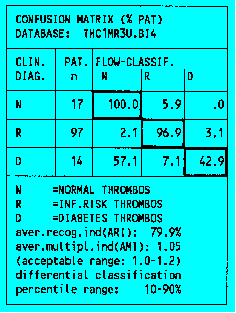
The values of each database column are then transformed into triple matrix characters by assigning: 0 to values between the percentiles, + to values above and - to values below the respective upper and lower percentiles (Fig.2).

- A confusion matrix is subsequently established between the known e.g. the clinical classification of reference and abnormal samples on the ordinate and the same classification states for the CLASSIF1 triple matrix classifier on the abscissa (Fig.3).

The classification result is ideal when a 100% recognition value is obtained in each diagonal box of the confusion matrix. This indicates correct classification of all samples by the CLASSIF1 classifier which usually does not occur with all database columns i.e. prior to the optimization process.
- The iterative optimization process is directed towards an increase of the sum of the diagonal box values. Single and combinations of database columns are temporarily excluded from the calculations to see whether their absence improves or deteriorates the classification result. Once no significant improvement is achieved any more, all database columns which neither alone nor in combination with other database columns have improved the result are definitively excluded from the final classification.
- Triple matrix classifiers are inherently standardized onto the group of reference samples during the classification process. Classifiers from different flow cytometers or laboratories can thus be compared in an instrument and laboratory independent way provided no differences between the respective reference groups are detected by the program.
- The advantage of this classification strategy is that triple matrix classifiers can be numerically compared during interlaboratory consensus trials e.g. on leukemia, HIV and thrombocyte classifications by immunephenotyping because they are portable.
- In view of immunephenotyping or other ring trials, the performance of triple matrix classifiers depends preferentially on individual laboratory precision rather than on interlaboratory accuracy. Instrument accuracy cancels out by percentile normalization on the mean values of the reference samples. Reference samples can be obtained in many instances from age and sex matched blood donors who represent a comparatively homogeneous group of persons.
- The relative independence of the classification results of interlaboratory accuracy represents an advantageous feature of triple matrix classifiers. It is a frequent experience in flow cytometric ring trials that good accuracy is more difficult to achieve than good intralaboratory precision especially when different instrument types are used by the participants. The reason for this consists in the high technical complexity of flow cytometers and cell sorters in view of e.g. optical signal perception, amplification, thresholding, filter characteristics and data processing. The recent development of various standard bead preparations improves but does not generally solve this problem.
- Furthermore the biochemical properties of many body cell systems during disease can be directly compared when the classifiers are standardized on peripheral blood cells. This standardization permits also to evaluate disease induced changes of blood cells localized in tissues or effusions.
- The elaboration of consensus classifiers opens the way for a general and standardized biochemical diagnosis and prognosis system in medicine.
For problems or comments, please contact: G.Valet, E-mail: valet@biochem.mpg.de, Max-Planck-Institut für Biochemie, Am Klopferspitz 18a, D-82152 Martinsried, Germany, Tel: +49/89/8578-2518, -2525, Fax: +49/89/8578-2563, INTERNET adress: http://www.biochem.mpg.de/valet/cellbio.html
Last Update: May 18, 1997